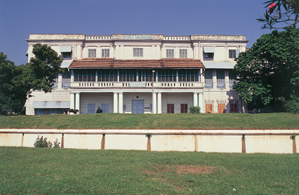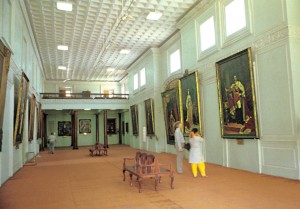Registered with the Registrar of Newspapers for India under R.N.I 53640/91
Vol. XXV No. 23, March 16-31, 2016
Know your Fort better
by Sriram V
 The Fort (Exchange) Museum.
The Fort (Exchange) Museum.
We are almost done with our tour of the Fort. As we walk from North Gate towards the main entrance, we cross Gloucester Street on our left. This is a narrow thoroughfare, its chief point of interest being what is now called Fort House, which dominates it. One of the older residences of Fort St George, not much is known of its history and it should certainly not be confused with the Fort House which was the first building constructed in this precinct and which gradually gave way for what is now the Assembly and Secretariat. The present Fort House is nevertheless impressive. It is 19th century in architecture, with a large courtyard, Mangalore tiled roof, thick lime-plastered walls and natural stone flooring. It serves as the residence of the Fort commandant today.
Crossing Fort House, we come to the Fort (or Exchange) Museum. This again is a historic building. What stood here once was the residence of Peter Massey Cassin, a free merchant of Madras – a term that requires some explanation. Technically, none other than the East India Company could be involved in the business of import and export. But in reality every one of its servants was involved in it. The Company paid very low salaries and encouraged its servants to indulge in what was termed ‘private trade’ and the higher you grew in the Company’s hierarchy, the more the opportunity.The Governor was supposed to accept a commission for virtually everything, ranging from goods supplied to the Company, be it arrack or betel leaf, to cloth that was being exported by the free merchants. Several of them also lent money at usurious rates of interest to the Nawab of the Carnatic, who, through a series of clever manoeuvres had been reduced to a puppet, living close to the Fort in the magnificent Chepauk Palace. Those who were rapidly on the make hoped to take their earnings and retire to a life of peace and politics in England. Such men were rather derisively referred to as Nabobs, a corruption of the Indian word Nawab and their practice of making money was termed as ‘shaking the great pagoda tree’, pagoda, a currency being severally used as a term for money. Even the few women in the Fort were said to be in business and according to one source some were “so forward as to have invoices, accounts current etc in their own names.” The most notorious among these was Mrs Nick, a woman was considered close to Governor Elihu Yale and so made money at a galloping pace. To hide any indication of their direct involvement, Company servants encouraged the coming in of several of their friends and relatives from England and set them up as free merchants. These were, as the name suggests, allowed to trade in a set of commodities not controlled by the Company.
With the passing of time, the number of free merchants in Madras increased, as it did all over India. As British control over India strengthened, the atmosphere became more conducive for business and free trade prospered often at the expense of the Company. At least two household names of Madras Presidency, Parry and Binny began business as free merchants. In the meanwhile, a number of agency houses had sprung up, almost all of them in banking, partly to finance the Nawab’s debts and partly to remit to England funds generated from the private trade of the East India Company servants. These free merchants had now become powerful enough to commandeer a space of their own in Fort St George. It was rather appropriate that Cassin’s residence developed as a place where people of his kind could conduct their business in comfort. A lottery was floated to fund the development and by 1795, the building designated as the Exchange House was completed. Even by 1790 it was partially open for use and the Exchange Coffee Tavern opened on the first floor in 1792. On the ground floor were warehouses, offices and a bank – the Madras Bank. The first floor also had the Long Room or the Exchange Hall where merchants, brokers, bankers and ships’ commanders could meet. Madeira was the preferred drink. In 1796, the first lighthouse of Madras was built on the roof of this building. Known as the Madras Light, it was on wooden scaffolding and had a primitive apparatus – 12 wicks in common finger glasses with small country mirrors for reflectors. The height above sea level was 100 feet and it ought to have been visible 17 miles in the sea but that was rarely the case. This was to last till 1837, when the second lighthouse of Madras came up in what is today the High Court compound.
 Once the Exchange Hall, now portrait gallery in the Fort Musuem.
Once the Exchange Hall, now portrait gallery in the Fort Musuem.
By then the Exchange had ceased to function here. Edward, the second Lord Clive, issued orders in 1801 for the free merchants to leave the Fort and settle on what would develop as First Line Beach, now Rajaji Salai. The Exchange building was left to the elements for several years until 1861 when it was refurbished as the Regimental Officers’ Mess. It was to remain that way till the late 1930s.
Early in 1944, Lt Col. DM Reid, the Managing Director of Beardsell & Co, and also a member of the Madras Legislative Council, suggested that the building be converted into a museum “for the exhibition of antiquities illustrating the historical evolution of the Province since the days of the East India Company.” In 1946, he, according to a reference in the Archaeological Survey of India’s Ancient India (1953), also sponsored the setting up of the museum, which was completed in 1948. By then Reid was probably back in England, having joined the vast contingent of European army officers, civilians and businessmen who opted to not stay on after Independence. Before leaving, Reid also penned the Story of Fort St George, a slim volume that also serves as a guided tour of the Fort.
The Exchange Museum, as it is now known, is not to be missed. While it spans three floors, recent renovations have revealed a subterranean level as well, which can be seen through a transparent tile in one of the rooms on the ground floor. On display at the museum are several cannons, statues of administrators during the Raj (Cornwallis dominates the stairwell), coins, porcelain, uniforms and weapons. The first floor, the original Long Room, retains its wooden flooring and here on display are several portraits of British royalty and Governors of Madras. The second floor, made over to the freedom struggle, does not have a very impressive collection but making up for all of that is the centre-piece – the only surviving Indian tricolour out of all the flags that were unfurled all over the country on August 15, 1947! The ASI is in charge of the museum.
The area surrounding the Exchange Museum has a number of cannons on display. These have been painstakingly catalogued by the Government Museum and the details have been compiled in a slim volume that is available on sale at the Egmore museum. From a study of this it is possible to identify each cannon and its origins. Suffice it to say that most of them have come from wars with Burma, China, the French in Pondicherry and the Marathas. At least three have come from the Danes, when their settlement at Tranquebar was made over to the British in 1845.
You can spend an entire day in the Fort Museum if you are so inclined. This completes your tour itinerary within the Fort for the main entrance is just a couple of minutes away from the museum. However, before taking leave it is worthwhile to list certain portions that are not accessible by the public. It is also necessary to ponder over the current state of the Fort. More on that in the final instalment of our tribute to Fort St George in its 375th year.

